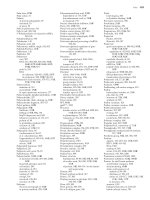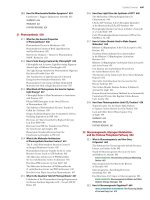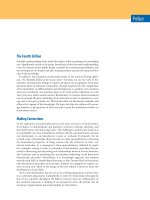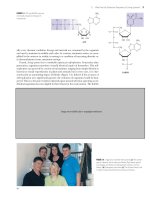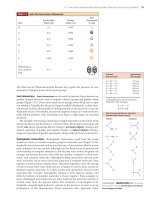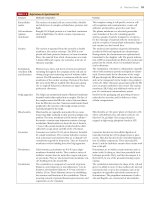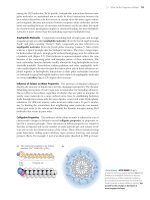Biochemistry, 4th Edition P92 pps
Bạn đang xem bản rút gọn của tài liệu. Xem và tải ngay bản đầy đủ của tài liệu tại đây (1.38 MB, 10 trang )
28.4 How Is DNA Replicated in Eukaryotic Cells? 873
of proteins that interact with Dbp11, leads to the recruitment of DNA polymerase to
the replication origins. (The protein acronyms refer to DNA polymerase-binding
[Dpb] and proteins encoded by genes that give a lethal phenotype when mutated in
Dpb11 mutant strains of yeast [Sld, or synthetic-lethal with Dpb11]. Collectively,
these proteins are referred to as the “11-3-2 complex”). The actions of S-CDK and
Cdc7-Dbf4 trigger bidirectional DNA replication from each origin, with the two di-
verging MCM complexes serving as helicases. Each helicase unwinds the duplex
DNA to provide single-stranded templates for the DNA polymerases that follow.
Proteins of the Prereplication Complex Are AAA؉ ATPase Family
Members
Cdc6, the Orc proteins, and MCM proteins are members of the AAA؉ ATPase
family, a group of proteins characterized by sequence and structural homology,
ATPase activity, and a general function as molecular chaperones. The binding of
both ORC and Cdc6 to chromatin in the process of pre-RC assembly is ATP-depen-
dent (Figure 28.12). ORC with ATP bound can bind to origins of replication and
recruit Cdc6 and Cdt1 to form a pre-RC in which both ORC and Cdc6 have bound
ATP. Cdc6 is required for the recruitment of the MCM proteins, specifically, a com-
plex of MCM2–7 with ATP-dependent helicase activity. To establish the pre-RC,
MCM2–7 must be stably associated with the origin, and this stability is achieved fol-
lowing ATP hydrolysis, first by Cdc6 and then by ORC.
Geminin Provides Another Control Over Replication Initiation
Geminin is a protein that provides another level of regulatory control over DNA
replication. Geminin inhibits DNA replication by preventing the incorporation of
MCM complexes into the pre-RC. Geminin is active during S, G
2
, and M phases, but
its destruction during mitosis permits replication initiation in G
1
. Geminin binds to
Cdt1, preventing it from recruiting MCM proteins to the pre-RC. Geminin exists as
a parallel coiled-coil homodimer. It interacts with Cdt1 in two ways: It has an array
of glutamate residues on its surface that interact with positive charges on Cdt1, and
an adjacent region on geminin interacts independently with the N-terminal region
of Cdt1.
Eukaryotic Cells Contain a Number of Different DNA Polymerases
At least 19 different DNA polymerases have been described in eukaryotic cells thus
far. These various polymerases have been assigned Greek letters in the order of their
discovery (Table 28.4 lists the principal ones). Multiple DNA polymerases participate
in leading and lagging-strand synthesis, but three—␣, ␦, and ⑀—share the major bur-
P
P
DNA
G
1
phase
Sld3
Sld2
Cdc45
Cdc45
Cdc45
S-CDK
MCM
Cdc7-Dbf-4
Cdc6 Cdt1
Origin of
replication
Dpb11
P
P
P
P
S phase
P
P
Sld3
Sld3
Dpb11
Sld2
Sld2
Dpb11
ORC
MCM
P
ORC
P
FIGURE 28.12 The initiation of DNA replication in
eukaryotic cells. Binding of the pre-RC to origins of repli-
cation is followed by loading of MCM hexameric heli-
cases, phosphorylation reactions mediated by S-CDK
and Cdc7-Dbf4, and the binding of the 11-3-2 complex.
The passage of the cell from G
1
to S is defined by these
events. DNA polymerases are recruited to the origins of
replication, where they can access single-stranded
regions of DNA and initiate DNA synthesis.
874 Chapter 28 DNA Metabolism: Replication, Recombination, and Repair
den. DNA polymerase ␣ has an associated primase subunit and functions in the initi-
ation of nuclear DNA replication. Given a template, it not only synthesizes an RNA
primer of about 10 nucleotides, but it then adds 20 to 30 deoxynucleotides to extend
the chain in the 5Ј→3Ј direction. DNA polymerase ␦, a heterotetrameric enzyme, is
the principal DNA polymerase in eukaryotic DNA replication. It interacts with PCNA
protein (PCNA stands for proliferating cell nuclear antigen). Through its association
with PCNA, DNA polymerase ␦ carries out highly processive DNA synthesis. PCNA is
the eukaryotic counterpart of the E. coli 
2
-sliding clamp; it clamps DNA polymerase
␦ to the DNA. Like 
2
, PCNA encircles the double helix, but in contrast to the prokary-
otic 
2
-sliding clamp, PCNA is a homotrimer, not a homodimer (Figure 28.13). DNA
polymerase ⑀ also plays a major role in DNA replication. It has an acidic C-terminal
extension lacking in other DNA polymerases and evidence suggests that this domain
is a sensor for DNA damage checkpoint control, halting DNA replication until the
damage is repaired. DNA polymerase ␥ is the DNA-replicating enzyme of mitochon-
dria; DNA polymerase  functions in DNA repair. The more recently discovered eu-
karyotic DNA polymerases (including , , , , and Rev1) are novel in that they are
more error-prone, resulting in lower fidelity of DNA replication. Nevertheless, they
have the important ability to function in DNA replication and repair when damaged
regions of DNA are encountered.
Other proteins involved in eukaryotic DNA replication include replication
protein A (RPA), an ssDNA-binding protein that is the eukaryotic counterpart
of SSB, and replication factor C (RFC). RFC loads the PCNA sliding clamp onto
replicating DNA, thus acting as the eukaryotic counterpart of the prokaryotic
␥-complex.
28.5 How Are the Ends of Chromosomes Replicated?
Telomeres are the structures at the ends of eukaryotic chromosomes. Telomeres
are short (5 to 8 bp), tandemly repeated, G-rich nucleotide sequences that form
protective caps 1 to 12 kbp long on the chromosome ends (see Chapter 11). Ver-
Subunits
Polymerase Localization and Function (mass in kD) Subunit Function
DNA polymerase ␣
Nuclear; initiation of nuclear DNA
replication
DNA polymerase ␦
Nuclear; principal polymerase in
leading and lagging strand synthesis;
highly processive
DNA polymerase ⑀
Nuclear; leading and lagging strand
synthesis, sensor of DNA damage
checkpoint control
DNA polymerase ␥
Mitochondria; mitochondrial DNA
replication
DNA polymerase 
DNA repair
TABLE 28.4
Biochemical Properties of the Principal Human DNA Polymerases
180 Catalytic subunit
68 Protein–protein interactions
55 Primase
48 Primase
125 Catalytic subunit
66 Structural
50 Interaction with PCNA
12 Protein–protein interactions
261 Catalytic subunit
59 Multimerization
17 Protein–protein interactions
12 Protein–protein interactions
140 Catalytic subunit
55 Processivity
39
(b)
(a)
x
x
FIGURE 28.13 Structure of the human PCNA homo-
trimer. (a) Ribbon representation of the PCNA trimer
(pdb id ϭ 1AXC) with an axial view of a B-form DNA
duplex in its center.The molecular mass of each PCNA
monomer is 37 kD.(b) Molecular surface of the PCNA
trimer-DNA complex.
28.5 How Are the Ends of Chromosomes Replicated? 875
tebrate telomeres have a TTAGGG consensus sequence. Telomeres are necessary
for chromosome maintenance and stability. DNA polymerases cannot replicate the
extreme 5Ј-ends of chromosomes because these enzymes require a template and a
primer and replicate only in the 5Ј→3Ј direction. Thus, lagging strand synthesis at
the 3Ј-ends of chromosomes is primed by RNA primase to form Okazaki fragments,
but these RNA primers are subsequently removed, resulting in gaps in the progeny
5Ј-terminal strands at each end of the chromosome after each round of replication
(“primer gap”; see Figure 28.14).
Telomerase is an RNA-dependent DNA polymerase. Telomerase maintains
telomere length by restoring telomeres at the 3Ј-ends of chromosomes. The RNA
upon which telomerase activity depends is actually part of the enzyme’s structure.
That is, telomerase is a ribonucleoprotein, and its RNA component contains a
9- to 30-nucleotide-long region that serves as a template for the synthesis of telom-
eric repeats at DNA ends. The human telomerase RNA component is 450 nucleo-
tides long; its template sequence is CUAACCCUAA
C (base-pairs with TTAGGG).
Telomerase uses the 3Ј-end of the DNA as a primer and adds successive TTAGGG
(b)
Telomerase
5Ј
DNA polymerase
5Ј
5Ј
Primer gap
3Ј
3Ј
3Ј
(a)
Primer gap
+
3Ј
5Ј
3Ј
5Ј
+
3Ј
5Ј
**
**
FIGURE 28.14 Telomere replication.(a) In replication of the lagging strand, short RNA primers are added (pink)
and extended by DNA polymerase.When the RNA primer at the 5Ј-end of each strand is removed, there is no
nucleotide sequence to read in the next round of DNA replication.The result is a gap (primer gap) at the 5Ј-end
of each strand (only one end of a chromosome is shown in this figure). (b) Asterisks indicate sequences at the
3Ј-end that cannot be copied by conventional DNA replication. Synthesis of telomeric DNA by telomerase
extends the 5Ј-ends of DNA strands, allowing the strands to be copied by normal DNA replication.
HUMAN BIOCHEMISTRY
Telomeres—A Timely End to Chromosomes?
Mammalian cells in culture undergo only 50 or so cell divisions be-
fore they die. Somatic cells are known to lack telomerase activity,
and thus, they inevitably lose bits of their telomeres with each cell
division. Telomerase activity is missing because the telomerase–
reverse transcriptase gene (the TRT gene) is switched off. This fact
has led to a telomere theory of cell aging, which suggests that cells
senesce and die when their telomeres are gone. In support of this
notion, a team of biologists headed by Calvin B. Harley at Geron
Corporation used recombinant DNA techniques to express the cat-
alytic subunit of human telomerase in skin cells in culture and ob-
served that such cells divide 40 times more after cells lacking this
treatment have become senescent. These results, although contro-
versial, may have relevance to the aging process.
876 Chapter 28 DNA Metabolism: Replication, Recombination, and Repair
repeats to it, employing its RNA as template over and over again (Figure 28.14,
see also the figure in the Chapter 11 Human Biochemistry box Telomeres and
Tumors).
28.6 How Are RNA Genomes Replicated?
Many viruses have genomes composed of RNA, not DNA. How then is the informa-
tion in these RNA genomes replicated? In 1964, Howard Temin noted that in-
hibitors of DNA synthesis prevented infection of cells in culture by RNA tumor
viruses such as avian sarcoma virus. On the basis of this observation, Temin pro-
posed that DNA is an intermediate in the replication of such viruses; that is, an RNA
tumor virus can use viral RNA as the template for DNA synthesis.
RNA viral chromosome⎯⎯→DNA intermediate⎯⎯→RNA viral chromosome
In 1970, Temin and David Baltimore independently discovered a viral enzyme ca-
pable of mediating such a process, namely, an RNA-directed DNA polymerase or, as
it is usually called, reverse transcriptase. All RNA tumor viruses contain such an en-
zyme within their virions (viral particles). RNA viruses that replicate their RNA
genomes via a DNA intermediate are classified as retroviruses.
Like other DNA and RNA polymerases, reverse transcriptase synthesizes polynu-
cleotides in the 5Ј→3Ј direction, and like all DNA polymerases, reverse transcriptase
requires a primer. Interestingly, the primer is a specific tRNA molecule captured by
the virion from the host cell in which it was produced. The 3Ј-end of the tRNA is base-
paired with the viral RNA template at the site where DNA synthesis initiates, and its
free 3Ј-OH accepts the initial deoxynucleotide once transcription commences. Re-
verse transcriptase then transcribes the RNA template into a complementary DNA
(cDNA) strand to form a double-stranded DNAϺRNA hybrid.
The Enzymatic Activities of Reverse Transcriptases
Reverse transcriptases possess three enzymatic activities, all of which are essential to
viral replication:
1. RNA-directed DNA polymerase activity, for which the enzyme is named (see Figure
12.10).
2. RNase H activity. Recall that RNase H is a nuclease that specifically degrades RNA
chains in DNAϺRNA hybrids (see Figure 12.10). The RNase H function of re-
verse transcriptase is an exonuclease activity that degrades the template genomic
RNA and also removes the priming tRNA after DNA synthesis is completed.
3. DNA-directed DNA polymerase activity. This activity replicates the ssDNA remaining af-
ter RNase H degradation of the viral genome, yielding a DNA duplex. This DNA du-
plex directs the remainder of the viral infection process or becomes integrated into
A DEEPER LOOK
RNA as Genetic Material
Whereas the genetic material of cells is dsDNA, virtually all plant
viruses, several bacteriophages, and many animal viruses have
genomes consisting of RNA. In most cases, this RNA is single
stranded. Viruses with single-stranded genomes use the single
strand as a template for synthesis of a complementary strand,
which can then serve as template in replicating the original strand.
Retroviruses are an interesting group of eukaryotic viruses with
single-stranded RNA genomes that replicate through a dsDNA in-
termediate. Furthermore, the life cycle of retroviruses includes an
obligatory step in which the dsDNA is inserted into the host cell
genome in a transposition event. Retroviruses are responsible for
many diseases, including tumors and other disorders. HIV-1, the
human immunodeficiency virus that causes AIDS, is a retrovirus.
28.7 How Is the Genetic Information Shuffled by Genetic Recombination? 877
the host chromosome, where it can lie dormant for many years as a provirus. Acti-
vation of the provirus restores the infectious state.
HIV reverse transcriptase is of great clinical interest because it is the enzyme for
replication of the AIDS virus. DNA synthesis by HIV reverse transcriptase is blocked
by nucleotide analogs such as AZT and 3TC (Figure 28.15). HIV reverse transcrip-
tase incorporates these analogs into growing DNA chains in place of dTMP (in the
case of AZT) or dCMP (in the case of 3TC). Once incorporated, these analogs block
further chain elongation because they lack a 3Ј-OH where the next incoming dNTP
can be added. HIV reverse transcriptase is error-prone: It incorporates the wrong
base at a frequency of 1 per 2000 to 4000 nucleotides polymerized. This high error
rate during replication of the HIV genome means that the virus is ever changing, a
feature that makes it difficult to devise an effective vaccine.
28.7 How Is the Genetic Information Shuffled
by Genetic Recombination?
Genetic recombination is the natural process by which genetic information is re-
arranged to form new associations. For example, compared to their parents, prog-
eny may have new combinations of traits because of genetic recombination. At the
molecular level, genetic recombination is the exchange (or incorporation) of one
DNA sequence with (or into) another. When recombination involves reaction be-
tween very similar sequences (homologous sequences) of DNA, the process is called
homologous recombination. When very different nucleotide sequences recombine,
it’s nonhomologous recombination. Transposition—the enzymatic insertion of a
transposon (a mobile segment of DNA, see pages 885–886) into a new location in the
genome—and nonhomologous recombination (incorporation of a DNA segment
whose sequence differs greatly from the DNA at the point of insertion) are two types
of recombination that play a significant evolutionary role. Nonhomologous recom-
bination occurs at a low frequency in all cells and serves as a powerful genetic force
that reshapes the genomes of all organisms. Homologous recombination involves
an exchange of DNA sequences between homologous chromosomes, resulting in
the arrangement of genes into new combinations. Homologous recombination is
generally used to fix the DNA so that information is not lost. For example, large le-
sions in DNA are repaired via recombination of the damaged chromosome with a
homologous chromosome.
The process underlying homologous recombination is termed general recombi-
nation because the enzymatic machinery that mediates the exchange can use essen-
tially any pair of homologous DNA sequences as substrates. Homologous recombi-
nation occurs in all organisms and is particularly prevalent during the production of
gametes (meiosis) in diploid organisms. In higher animals—that is, those with im-
mune systems—recombination also occurs in the DNA of somatic cells responsible
for expressing proteins of the immune response, such as the immunoglobulins. This
somatic recombination rearranges the immunoglobulin genes, dramatically increas-
ing the potential diversity of immunoglobulins available from a fixed amount of ge-
netic information. Homologous recombination can also occur in bacteria. Indeed,
even viral chromosomes undergo recombination. For example, if two mutant viral
particles simultaneously infect a host cell, a recombination event between the two
viral genomes can lead to the formation of a virus chromosome that is wild-type.
General Recombination Requires Breakage and Reunion
of DNA Strands
Recombination occurs by the breakage and reunion of DNA strands so that a phys-
ical exchange of parts takes place. Matthew Meselson and J. J. Weigle demonstrated
this in 1961 by coinfecting E. coli with two genetically distinct bacteriophage
CH
3
O
O
O
N
N
H
O
HH
H
H
H
HOCH
2
N
N
O
S
H
H
H
H
HOCH
2
N
N
+
–
NH
2
N
(a)
(b)
FIGURE 28.15 The structures of AZT (3Ј-azido-2Ј,3Ј-
dideoxythymidine) and 3TC (2Ј,3Ј-dideoxy-3Ј-
thiacytidine). These nucleosides are phosphorylated
in vitro to form deoxynucleoside-5’-triphosphate sub-
strate analogs for HIV reverse transcriptase.
878 Chapter 28 DNA Metabolism: Replication, Recombination, and Repair
strains, one of which had been density-labeled by growth in
13
C- and
15
N-containing
media (Figure 28.16). The phage progeny were recovered and separated by CsCl
density gradient centrifugation. Phage particles that displayed recombinant geno-
types were distributed throughout the gradient while parental (nonrecombinant)
genotypes were found within discrete “heavy” and “light” bands in the density gra-
dient. The results showed that recombinant phage contained DNA derived in vary-
ing proportions from both parents. The obvious explanation is that these recombi-
nant DNAs arose via the breakage and rejoining of DNA molecules.
A second important observation made during this type of experiment was that
some of the plaques formed by the phage progeny contained phage of two differ-
ent genotypes, even though each plaque was caused by a single phage infecting one
bacterium. Therefore, some infecting phage chromosomes must have contained a
region of heteroduplex DNA, duplex DNA in which a part of each strand is con-
tributed by a different parent (Figure 28.17).
Homologous Recombination Proceeds According
to the Holliday Model
In 1964, Robin Holliday proposed a model for homologous recombination that has
proved to be correct in its essential features (Figure 28.18). The two homologous
DNA duplexes are first juxtaposed so that their sequences are aligned. This process
of chromosome pairing is called synapsis (Figure 28.18a). Holliday suggested that
recombination begins with the introduction of single-stranded nicks in the DNA at
homologous sites on the two paired chromosomes (Figure 28.18b). The two du-
plexes partially unwind, and the free, single-stranded end of one duplex begins to
base-pair with its nearly complementary, single-stranded region along the intact
strand in the other duplex, and vice versa (Figure 28.18c). This strand invasion is
followed by ligation of the free ends from different duplexes to create a cross-
Infect bacteria with a
mixture of heavy and
light phage
Recombination occurs
Phage assembly and
cell lysis
Heavy phage ABC Light phage abc
Phage progeny are
centrifuged on
CsCl gradient
Light phage abc
Recombinant phage
Abc, aBc, abC, etc.
Heavy phage ABC
ᮤ
ANIMATED FIGURE 28.16 Meselson and Weigle’s experiment. Density-labeled,“heavy”
phage, symbolized as ABC phage, was used to coinfect bacteria along with “light” phage, the abc phage.
The progeny from the infection were collected and subjected to CsCl density gradient centrifugation.
Parental-type ABC and abc phage were well separated in the gradient, but recombinant phage (ABc, Abc,
aBc, aBC, and so on) were distributed diffusely between the two parental bands because they contained
chromosomes constituted from fragments of both “heavy” and “light” DNA. See this figure animated at
www.cengage.com/login.
+–
XX
Yy
ZZ
Heteroduplex DNA
(+ and – strands)
Semiconservative
DNA replication
+–
XX
YY
ZZ
Progeny phage of 2 different
genotypes
+–
XX
yy
ZZ
FIGURE 28.17 The generation of progeny bacteriophage of two different genotypes from a single phage parti-
cle carrying a heteroduplex DNA region within its chromosome.The heteroduplex DNA is composed of one
strand that is genotypically XYZ (the ϩ strand), and the other strand that is genotypically XyZ (the Ϫ strand).
That is, the genotype of the two parental strands for gene Y is different (one is Y, the other y).
28.7 How Is the Genetic Information Shuffled by Genetic Recombination? 879
stranded intermediate known as a Holliday junction (Figure 28.18d). The cross-
stranded junction can now migrate in either direction (branch migration) by un-
winding and rewinding of the two duplexes (Figure 28.18e). Branch migration re-
sults in strand exchange; heteroduplex regions of varying length are possible. In
order for the joint molecule formed by strand exchange to be resolved into two
DNA duplex molecules, another pair of nicks must be introduced. Resolution can
AZ
+
–
–
+
az
Nicking
Strand invasion
Ligation
Branch migration
Arms conceptually bent
“up” and “down”
AZ
az
+
–
+
–
+
–
–
+
+
–
–
+
(–) strands cleaved at junction,
strands resolved, religated
(+) strands cleaved at junction,
strands resolved, religated
Patch recombinant heteroduplex Splice recombinant heteroduplex
(a)
(b)
(c)
(d)
(e)
(f)
(g) (h)
N
W
E
S
EW cleavage:
NS cleavage:
ACTIVE FIGURE 28.18 The Holliday
model for homologous recombination.The ϩ signs
and Ϫ signs label strands of like polarity. For exam-
ple, assume that the two strands running 5Ј→3Ј as
read left to right are labeled ϩ; and the two strands
running 3Ј→5Ј as read left to right are labeled Ϫ.
Only strands of like polarity exchange DNA during
recombination. (See text for detailed description.)
Test yourself on the concepts in this figure at
www.cengage.com/login.
880 Chapter 28 DNA Metabolism: Replication, Recombination, and Repair
be represented best if the duplexes are drawn with the chromosome arms bent “up”
or “down” to give a planar representation (Figure 28.18f). Nicks then take place, ei-
ther at E and W, that is, in the Ϫ strands that were originally nicked (see Figure
28.18b), or at N and S, that is, in the ϩ strands (the strands not previously nicked).
Duplex resolution is most easily kept straight by remembering that ϩ strands are
complementary to Ϫ strands and any resultant duplex must have one of each. Nicks
made in the strands originally nicked lead to DNA duplexes in which one strand of
each remains intact. Although these duplexes contain heteroduplex regions, they
are not recombinant for the markers (AZ, az) that flank the heteroduplex region;
such heteroduplexes are called patch recombinants (Figure 28.18g). Nicks intro-
duced into the two strands not previously nicked yield DNA molecules that are both
heteroduplex and recombinant for the markers A/a and Z/z; these heteroduplexes
are termed splice recombinants (Figure 28.18h). Although this Holliday model ex-
plains the outcome of recombination, it provides no mechanistic explanation for
the strand exchange reactions and other molecular details of the process.
The Enzymes of General Recombination Include RecA, RecBCD,
RuvA, RuvB, and RuvC
To illustrate recombination mechanisms, we focus on general recombination as it
occurs in E. coli. The principal players in the process are the RecBCD enzyme com-
plex, which initiates recombination; the RecA protein, which binds single-stranded
DNA, forming a nucleoprotein filament capable of strand invasion and homolo-
gous pairing; and the RuvA, RuvB, and RuvC proteins, which drive branch migra-
tion and process the Holliday junction into recombinant products. Eukaryotic
homologs of these prokaryotic recombination proteins have been identified, indi-
cating that the fundamental process of general recombination is conserved across
all organisms.
The RecBCD Enzyme Complex Unwinds dsDNA and Cleaves
Its Single Strands
The RecBCD complex is composed of the proteins RecB (140 kD; 1180 amino acids),
RecC (130 kD; 1122 amino acids), and RecD (67 kD; 608 amino acids). This multi-
functional enzyme complex has both helicase and nuclease activity and initiates re-
combination by attaching to the end of a DNA duplex (or at a double-stranded break
in the DNA) and using its ATP-dependent helicase function to unwind the dsDNA
(Figure 28.19a). RecB and RecD are helicases powered by ATP hydrolysis; each con-
sumes an ATP per base pair of DNA traversed. The RecD motor is faster than the
RecB motor and leads the way. The greater speed of RecD causes the DNA to loop
out between RecD and RecB. The RecB subunit contains the nuclease domain. As
RecBCD progresses along unwinding the duplex, the RecB nuclease activity cleaves
both of the newly formed single strands (although the strand that provided the 3Ј-end
at the RecBCD entry site is cut more frequently than the 5Ј-terminal strand [Figure
28.19b]). SSB (and some RecA protein) readily binds to the emerging single strands.
Sooner or later, RecBCD encounters a particular nucleotide sequence, a so-called Chi
(or ) site, characterized by the sequence 5Ј-GCTGGTGG-3Ј. These sites are re-
combinational “hot spots”; 1009 sites have been identified in the E. coli genome
(on average, about one every 4.5 kb of DNA). When a sequence is encountered by
a RecBCD complex approaching its 3Ј-side (the G-3Ј-side), RecBCD cleaves the
-bearing DNA strand four to six bases to the 3Ј side of (Figure 28.19c). RecBCD
flips so that the RecB motor leads the way, and the RecBCD complex no longer ex-
presses nuclease activity against the 3Ј-terminal strand, but nuclease activity against
the 5Ј-terminal strand increases (Figure 28.19d).
Resuming its helicase function, RecBCD unwinds the dsDNA, and collectively
these processes generate an ssDNA tail bearing a site at its 3Ј-terminal end.
This ssDNA may reach several kilobases in length. RecA protein now binds to the
3Ј-terminal strand to form a nucleoprotein filament (Figure 28.19e). This filament
28.7 How Is the Genetic Information Shuffled by Genetic Recombination? 881
is active in pairing and strand invasion with a homologous region in another dsDNA
molecule.
The RecA Protein Can Bind ssDNA and Then Interact with Duplex DNA
The RecA protein, or recombinase, is a multifunctional protein that acts in general
recombination (Figure 28.20a). RecA mediates the ATP-dependent DNA strand
exchange reaction leading to formation of a Holliday junction (Figure 28.18b–f). In
the presence of ATP and ssDNA, RecA forms a right-handed helical filament having
(a)
(b)
(c)
(d)
(e)
3Ј
3Ј
3Ј
3Ј
5Ј
5Ј
5Ј
5Ј
3Ј
5Ј
3Ј
5Ј
3Ј
5Ј
3Ј
5Ј
3Ј
5Ј
3Ј
5Ј
χ
3Ј
5Ј
3Ј
5Ј
χ
χ
χ
χ
RecBCD
SSB
RecA
RecA
Binding of RecBCD to
DNA end; unwinding
Nonspecific cleavage
(3Ј more than 5Ј);
SSB, RecA binding
χ encounter and cleavage 3Ј to χ
Displacement of SSB;
preferential binding of RecA;
enhanced 5Ј-terminal cleavage
Pairing with homologous
DNA du
p
lex and strand invasion
χ
FIGURE 28.19 Model of RecBCD-dependent initiation of
recombination. (a) RecBCD binds to a duplex DNA end,
and its helicase activity begins to unwind the DNA dou-
ble helix.“Rabbit ears”of ssDNA loop out from RecBCD
because the rate of DNA unwinding exceeds the rate of
ssDNA release by RecBCD. (b) As it unwinds the DNA,
SSB (and some RecA) bind to the single-stranded re-
gions; the RecBCD endonuclease activity randomly
cleaves the ssDNA, showing a greater tendency to cut
the 3Ј-terminal strand rather than the 5Ј-terminal strand.
(c) When RecBCD encounters a properly oriented site,
the 3Ј-terminal strand is cleaved just below the 3Ј-end
of . (d) RecBCD now directs the binding of RecA to the
3Ј-terminal strand, as RecBCD endonuclease activity now
acts more often on the 5Ј-terminal strand. (e) A nucleo-
protein filament consisting of RecA-coated 3Ј-strand
ssDNA is formed.This nucleoprotein filament is capable
of homologous pairing with a dsDNA and strand inva-
sion. (Adapted from Figure 2 in Eggleston, A. K., and West, S. C.,
1996. Exchanging partners: recombination in E. coli.Trends in
Genetics 12:20–25; and Figure 3 in Eggleston, A. K., and West, S. C.,
1997. Recombination initiation: Easy as A, B, C, D ….? Current
Biology 7:R745–R749.)
882 Chapter 28 DNA Metabolism: Replication, Recombination, and Repair
six monomers per turn, with each monomer spanning about three nucleotides of
DNA. The RecA nucleoprotein filament serves as a scaffold upon which the events of
recombination take place. This filament has a deep spiral groove large enough to en-
compass three strands of DNA. Although RecA-bound ssDNA is relatively stretched
and underwound, with about 18.5 nucleotides per turn, its local conformation re-
sembles B-DNA (Figure 28.20b). Thus, when dsDNA adds to the complex, the ssDNA
is poised to search for the sequence homology that leads to strand exchange.
Procession of strand separation of dsDNA and the re-pairing into hybrid strands
along the DNA duplex initiates branch migration (Figure 28.21b). Branch migration
drives the displacement of the homologous DNA strand from the DNA duplex and
its replacement with the ssDNA strand, a process known as single-strand assimilation
(b)
C-term
N-term(a)
L1
FIGURE 28.20 (a) RecA, a 352-residue, 38-kD protein,
with dATP in the ATP-binding site (pdb id ϭ 2ODN).
(b) Structure of a fused RecA hexamer with bound ssDNA
(as poly(dT)
18
, magenta). Each of the six RecA units is a dif-
ferent color and each has a bound ADP molecule (marine
blue).The adenine nucleotide-binding sites lie at the inter-
faces between RecA units (pdb id ϭ 3CMU).
5Ј
3Ј
5Ј
3Ј
3Ј
5Ј
3Ј
5Ј
3Ј
5Ј
5Ј
3Ј
5Ј
5Ј
5Ј
3Ј
5Ј
3Ј
5Ј
3Ј
3Ј
5Ј
(a)
RecA
Homologous
DNA duplex
(b)
(c)
SSB
FIGURE 28.21 Model for homologous recombination as promoted by RecA enzyme.(a) RecA protein (and SSB) aid
strand invasion of the 3Ј-ssDNA into a homologous DNA duplex, (b) forming a D-loop. (c) The D-loop strand that
has been displaced by strand invasion pairs with its complementary strand in the original duplex to form a Holli-
day junction as strand invasion continues.
